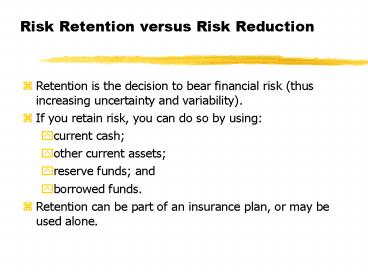Risk Retention versus Risk Reduction - PowerPoint PPT Presentation
1 / 10
Title:
Risk Retention versus Risk Reduction
Description:
Hold onto cash longer than with insurance thus potentially greater ... Captive Insurers (creating/acquiring insurer to funnel firm's risks & losses through) ... – PowerPoint PPT presentation
Number of Views:314
Avg rating:3.0/5.0
Title: Risk Retention versus Risk Reduction
1
Risk Retention versus Risk Reduction
- Retention is the decision to bear financial risk
(thus increasing uncertainty and variability). - If you retain risk, you can do so by using
- current cash
- other current assets
- reserve funds and
- borrowed funds.
- Retention can be part of an insurance plan, or
may be used alone.
2
Benefits of Retention
- Eliminate premium loadings
- No insurance market cycles
- Reduced moral hazard
- No insurer uncertainty (due to asymmetrical
information) - No insurance price regulation
3
Benefits of Retention (Contd)
- Hold onto cash longer than with insurance thus
potentially greater investment gains. - Only pay if losses happen.
- Over the long term on average, usually costs less
than insurance.
4
Disadvantages of Retention
- You bear the risk, which can be high if retained
amount is high. - You do not enjoy the predictive benefits of the
Law of Large Numbers. - If you cannot afford to live through to the long
term financially, the fact that retention tends
to cost less than insurance over time wont
matter.
5
Retention Decision Rules of Thumb
- Retain risk where
- Frequency and severity are both expected to be
low by your definition of low. - You can transfer excess amounts of risk - those
amounts above your low limit. - If you do not tend to invest well (or do not have
high levels of investment gains) - you may be better off financially to retain.
Since retention requires reserving by investing
in safe assets, your investment opportunity
cost is not as high as it would be for a firm
that typically expects relatively high rates of
return from its investments.
6
Specific Retention Plans
- Current Funds
- Reserves
- Tax favored
- Non-tax favored
- Captive Insurers
- Risk Retention Groups
- Self Insurance Pools
7
Cash Flow Impacts of Alternative Retention
Strategies
- Using Current Funds
- No cost until loss is incurred
- Can create extreme cash volatility
- May necessitate borrowing (and potentially at
relatively high rates) - Can deduct payments as ordinary expenses, but may
lose tax advantages in years with accounting
losses
8
Cash Flow Impacts of Alternative Retention
Strategies (Contd)
- Using Reserves
- Must apply and be approved for tax-favored
treatment of such funds set aside - Funds cannot be invested at high rates of return,
resulting in opportunity cost of investment - Catastrophic loss may necessitate borrowing
9
Cash Flow Impacts of Alternative Retention
Strategies (Contd)
- Captive Insurers (creating/acquiring insurer to
funnel firms risks losses through) - Tax favored treatment is questionable
- Can keep premiums in house
- Requires in-house actuarial insurance expertise
- Expensive to meet state insurance regulatory
requirements - Reinsurance still is necessary
10
Cash Flow Impacts of Alternative Retention
Strategies (Contd)
- Risk Retention Groups Self Insurance Pools
- Tax-favored treatment if set up correctly
- Adverse selection can be a significant issue
- Provides a less expensive alternative in states
or industries where insurance is relatively
expensive - Not allowed in all states
- Reinsurance still is necessary































